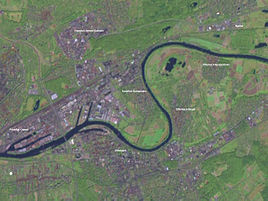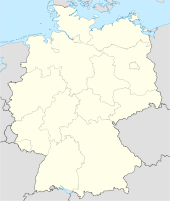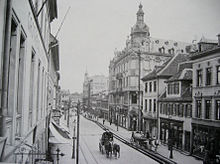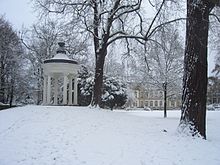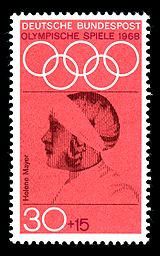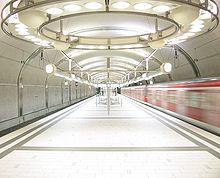- Offenbach am Main
-
Offenbach Satellite view of Offenbach and Eastern Frankfurt 
Coordinates 50°6′0″N 8°48′0″E / 50.1°N 8.8°ECoordinates: 50°6′0″N 8°48′0″E / 50.1°N 8.8°E Administration Country Germany State Hesse Admin. region Darmstadt District Urban district Mayor Horst Schneider (SPD) Basic statistics Area 44.90 km2 (17.34 sq mi) Elevation 62 m (203 ft) Population 120,435 (31 December 2010)[1] - Density 2,682 /km2 (6,947 /sq mi) Other information Time zone CET/CEST (UTC+1/+2) Licence plate OF Postal codes 63001 - 63075 Area code 069 Website www.offenbach.de Offenbach am Main is a city in Hesse, Germany, located on southside of the river Main just next to Frankfurt am Main. In 2009 it had a population of 118,770. The city is part of the Frankfurt/Rhine-Main metropolitan area as well as the Frankfurt urban area.
Offenbach was a center of the leather industry, which has however declined in the last decades. It is still the seat of the Deutsches Leder Museum (German Leather Museum), and also of the international leather fair.
Contents
History
The first documented reference to Offenbach appears in 770.During the Middle Ages Offenbach passed through many hands. Only in 1486 could the Count Ludwig of Isenenburg finally take control of city for his family, and 1556 Count Reinhard of Isenburg relocated his Residence to Offenbach, building a palace, the Isenburger Schloß (Isenburg Palace), which was completed in 1559. It was destroyed by fire in 1564 and rebuilt in 1578.
In 1635 Offenbach given to the Landgraves of Hesse-Darmstadt but it was returned to the Isenburg-Birstein Count (later Prince) in 1642 and remained in that Principality until 1815 when the Congress of Vienna gave the city to the Austrian Emperor, Francis II, Holy Roman Emperor. A year later it was given to the Grand Duchy of Hesse-Darmstadt.
Always very close to the city centre of Frankfurt, Offenbach was a popular location for business. The town has an own trade fair, many companies opened facilities because of less restrictions and no close businesses. French Protestants (Huguenots) came in the 17th centuries and settled in Offenbach and contributed to making Offenbach a prosperous city e.g. bringing the knowledge of tobacco with them and turning Offenbach into a centre for rolling cigars. The town was more cosmopolitan than Frankfurt, famous persons like Goethe and Mozart visited it several times.
The Rumpenheim Palace and its park was a popular destination of monarchs in the 19th century. The city was thereafter ruled by Grand Dukes of Hesse and by Rhine until the monarchy was abolished in 1918.
During the Second World War a third of the city was destroyed by Allied bombing which claimed 467 lives. With the new district Lauterborn the city was expanded to south in the 1960s. On the border to Frankfurt the office district Kaiserlei was built.
Boroughs of Offenbach
The inner town of Offenbach is quite large and has only a few suburbs. In the east the three incorporated: Bürgel (incorporated 1908), Bieber (incorporated April 1, 1938), and Rumpenheim (incorporated April 4, 1942) and in the south the newer suburbs Lauterborn and Rosenhöhe, the office town Kaiserlei and the industral area Waldheim.
Economy
 The 120-meter high "City-Tower" is mainly used as the German headquarters of Capgemini
The 120-meter high "City-Tower" is mainly used as the German headquarters of Capgemini
Until the early 1970s Offenbach was dominated by the machine-building and leather industries. The city hosts the German Association for Electrical, Electronic and Information Technologies to this day. The Deutscher Wetterdienst, commonly abbreviated as DWD, (translated from German as German Meteorological Service), residing in the Westend district.
Offenbach was also the European center of typography, with Gebr. Klingspor and Linotype (inventors of Optima or Palatino typeface) moving to nearby Eschborn in the 1970s and MAN Roland printing machines still a major employer today. Typography and design still remain important with a cluster of graphic design and industrial design companies, as well as the university level HfG Offenbach design school and the Klingspor Museum.
In recent years Offenbach has become a popular location for a wide array of services, especially from the transport sectors. Offenbach is the host to the European headquarters of Honda, Hyundai Motors.[citation needed] and Kumho Tires.[2]
Economy of OffenbachMain sights
In Offebach there is no specific Old Town, but there are several buildings to see which survived bombing during the war and have been restored. One of them is the neo-Baroque palace Büsingpalais with the Büsingpark, reconstructed in the 1980s. Now it is used as a congress center close to the Sheraton hotel. Between the shopping area and the Main, is the Lilipark and the Lilitemple, named after Goethe’s fiancee Lili Schönemann. The most important building is the Isenburg Palace a renaissance palace from 1576 with an impressive facade. It is today used by the Offenbach Design University which is next to it. There is also a neoclassic palace in the borough Rumpenheim, the Rumpenheimer Schloss it now serves exclusively as domestic dwellings but the park is public.
- Isenburg Palace, a typical Renaissance building from 1576, now used by the Offenbach Design University
- Büsingpalais with Büsingpark
- Wilhelmsplatz a square with coffee houses and three times a week a market.
- Buildings of the French Protestant Church and the French Protestant Community.
- Rumpenheim Palace.
- Former Synagogue "Capitol" (now a concert hall next to the new Synagogue).
- The Westend Quarter (19th century).
- Several art deco apartment houses.
- Buildings by early 20th century architect Hugo Eberhardt: "Heyne" Factory, main building of the Design University, AOK Insurance building.
- Prefabricated houses by Egon Eiermann in Lauterborn
Culture
There are several festivals in Offebach, some of these are:
- Lichterfest im Büsing-Park (festival of lights in the park of the Büsing palais)
- Nacht der Museen (with Frankfurt)
- Mainuferfest
- Cross Media Night
Museums
- German Leather Museum
- Klingspor Museum, museum of typography and calligraphy
- Haus der Stadtgeschichte, municipal historical museum
- Rosenheim-Museum for the painter Bernd Rosenheim
Gallery
Population history
Year Population 1540 480 1685 600 1718 1.500 1800 5.000 1816 6.210 1825 7.147 1828 7.466 1830 7.498 December 1, 1834 9.433 December 1, 1840 9.597 December 3, 1843 9.883 December 3, 1846 11.565 December 3, 1852 11.087 December 3, 1855 13.724 December 3, 1861 16.708 December 3, 1864 19.390 Year Population December 3, 1867 20.322 December 1, 1871 22.689 December 1, 1875 26.012 December 1, 1880 28.597 December 1, 1885 31.704 December 1, 1890 35.064 December 2, 1895 39.388 December 1, 1900 50.468 December 1, 1905 59.765 December 1, 1910 75.583 December 1, 1916 67.197 December 5, 1917 67.483 October 8, 1919 75.380 June 16, 1925 79.362 June 16, 1933 81.329 May 17, 1939 85.140 Year Population December 31, 1945 70.600 October 29, 1946 75.479 September 13, 1950 89.030 September 25, 1956 104.283 June 6, 1961 116.195 December 31, 1965 117.893 May 27, 1970 117.306 December 31, 1975 115.251 December 31, 1980 110.993 December 31, 1985 107.090 May 25, 1987 111.386 December 31, 1990 114.992 December 31, 1995 116.533 December 31, 2000 117.535 September 30, 2005 119.833 March 31, 2007 117.224 Mayors from 1824 - 2009
- 1824–1826: Peter Georg d'Orville
- 1826–1834: Heinrich Philipp Schwaner
- 1834–1837: Peter Georg d'Orville
- 1837–1849: Jonas Budden
- 1849–1859: Friedrich August Schäfer
- 1859–1867: Johann Heinrich Dick
- 1867–1874: Johann Martin Hirschmann
- 1874–1882: Hermann Stölting
- 1883–1907: Wilhelm Brink
- 1907–1919: Andreas Dullo
- 1919–1933: Max Granzin
- 1947–1949: Johannes Rebholz
- 1950–1957: Hans Klüber
- 1957–1974: Georg Dietrich
- 1974–1980: Walter Buckpesch
- 1980–1986: Walter Suermann
- 1986–1994: Wolfgang Reuter
- 1994–2006: Gerhard Grandtke
- 2006–: Horst Schneider
Notable residents
Notable people born in Offenbach include:
- Gottfried Böhm (1923-) Architect who won the Pritzker Architecture Prize in 1986
- Moritz Wilhelm August Breidenbach (1796–1857) a German jurist
- Ray Bumatai, born here
- Heinrich von Brentano (1904–1964) a German conservative politician
- Hans Hotter
- Prince Philipp of Hesse
- Helene Mayer, fencer, born here
Others who have resided in Offenbach include:
- Rabbi Abraham Bing (1752–1841)
- Jacob Frank
- Heinrich Kaminski, worked here
- Friedrich Kellner, attended Goethschule here
- Karlgeorg Hoefer
- Regina Jonas, first female Rabbi, ordained in Offenbach
- Rudolf Koch, worked and taught here
- Fritz Kredel, studied here
- Philipp Mainländer, died here
- Jacques Offenbach
- Götz Otto, born here
- Anthony Rother Electronic musician
- Snap!, German dance group
- Berthold Wolpe
People from Offenbach-
RudolfKoch.jpg
Rudolf Koch, typographer
Transport
Roads
The streets of central Offenbach are usually congested with cars during the rush hour. Some areas, especially around the shopping streets, are pedestrian-only streets. There are numerous car parks located throughout the city. The Offenbacher Kreuz is an Autobahn interchange where the Autobahnen A 3 (Cologne-Würzburg) and A 661 meet. The A661 crosses the (Cologne-Würzburg) and A 5 (Basel-Hannover).
Public transport
The city is connected by a mayor line of the S-Bahn railway system to Frankfurt. The station in the city center is Marktplatz. The station Kaiserlei could be used from Frankfurt and Offenbach with the same price. In general, six stations are located in Offenbach: Offenbach-Kaiserlei, Offenbach-Ledermuseum, Offenbach-Marktplatz, Offenbach-Ost, Offenbach-Bieber, Offenbach-Waldhof. The city´s public transportation services OVB and NIO connect all city districts to downtown by bus lines. Information about the public transport can be found on the RMV website Since the construction of the S-Bahn, the central train station, the Offenbach Hauptbahnhof, is no longer considered important.
Frankfurt Airport
The city is accessed from around the world via the Frankfurt Airport, (Flughafen Frankfurt am Main) which is located 12 km (7 mi) from Offenbach. The airport can be reached by car or bus and has two train stations, one for regional and one for long-distance traffic. The S-Bahn lines S8 and S9 (direction "Offenbach Ost or "Hanau"), departing from the regional traffic station, take 15 minutes from the airport to get to Offenbach.
Bicycles
In the summer, seasonal bicycles could be rented from nextbike, a rental company in Offenbach and Frankfurt. Only a credit card and a mobile phone is necessary to take a bike parked somewhere in the town.
Sport
home to the football club Kickers Offenbach stadium "Bieberer Berg"
Offenbach hosts the German association football club Kickers Offenbach. The club was founded in 1901.
Twinned cities
 Puteaux, France, since 1955
Puteaux, France, since 1955 Esch-sur-Alzette, Luxembourg, since 1956
Esch-sur-Alzette, Luxembourg, since 1956 Mödling, Austria, since 1956
Mödling, Austria, since 1956 Sint Gillis/Saint-Gilles-les-Bruxelles, Brussels, since 1956
Sint Gillis/Saint-Gilles-les-Bruxelles, Brussels, since 1956 Yangzhou, People's Republic of China, since 1997
Yangzhou, People's Republic of China, since 1997
References
- ^ "Die Bevölkerung der hessischen Gemeinden" (in German). Hessisches Statistisches Landesamt. 31 December 2010. http://www.statistik-hessen.de/static/publikationen/A/AI2_AII_AIII_AV_10-1hj_pdf.zip.
- ^ "Impressum." Kumho Tyres. Retrieved on 9 November 2011. "Brüsseler Platz 1 63067 Offenbach am Main"
External links
- Offenbach website (German)
Cities in Germany by population 1,000,000+ 500,000+ 200,000+ Aachen · Augsburg · Bielefeld · Bochum · Bonn · Braunschweig · Chemnitz · Duisburg · Erfurt · Freiburg im Breisgau · Gelsenkirchen · Halle an der Saale · Karlsruhe · Kiel · Krefeld · Lübeck · Magdeburg · Mannheim · Münster · Mönchengladbach · Oberhausen · Rostock · Wiesbaden · Wuppertal
100,000+ Bergisch Gladbach · Bottrop · Bremerhaven · Cottbus · Darmstadt · Erlangen · Fürth · Göttingen · Hagen · Hamm · Heidelberg · Heilbronn · Herne · Hildesheim · Ingolstadt · Jena · Kassel · Koblenz · Leverkusen · Ludwigshafen · Mainz · Moers · Mülheim an der Ruhr · Neuss · Offenbach am Main · Oldenburg · Osnabrück · Paderborn · Pforzheim · Potsdam · Recklinghausen · Regensburg · Remscheid · Reutlingen · Saarbrücken · Salzgitter · Siegen · Solingen · Trier · Ulm · Wolfsburg · Würzburg
 Urban and rural districts in the state of Hesse in Germany
Urban and rural districts in the state of Hesse in Germany 
Urban districts Rural districts Bergstraße · Darmstadt-Dieburg · Fulda · Gießen · Groß-Gerau · Hersfeld-Rotenburg · Hochtaunuskreis · Kassel · Lahn-Dill-Kreis · Limburg-Weilburg · Main-Kinzig-Kreis · Main-Taunus-Kreis · Marburg-Biedenkopf · Odenwaldkreis · Offenbach · Rheingau-Taunus-Kreis · Schwalm-Eder-Kreis · Vogelsbergkreis · Waldeck-Frankenberg · Werra-Meißner-Kreis · WetteraukreisCategories:- Cities in Hesse
- Offenbach am Main
- Historic Jewish communities
Wikimedia Foundation. 2010.

